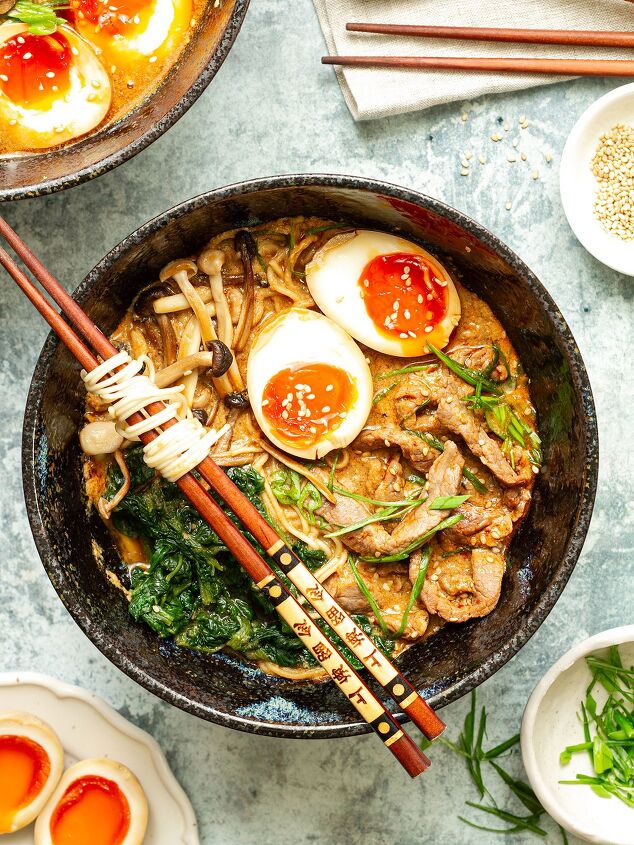Miso Glazed Aubergine (Japanese Miso Eggplant)

If you think that incredible flavour requires a long cooking time, this 15-minute miso-glazed aubergine (Japanese miso eggplant) will prove you wrong. This has to be one of my favourite vegetarian dishes because its soft, buttery, and umami deliciousness blows me away every time.
It's a versatile dish that I make often because it's quick, simple, and only requires 4 core ingredients. You can grab aubergine/eggplant on your way home and enjoy its warming, melt-in-your-mouth deliciousness.
In Japan, miso aubergine is cooked using the grilling method called "Yaki Nasu." The aubergines are halved, scored, and then grilled until the flesh becomes tender and lightly charred. Oven grilling/broiling gives a similar effect and is super speedy too.
For more speedy dinners that use miso paste check out my Spicy Miso Pasta and Miso Beef Ramen.
The post contains additional information and helpful tips to ensure the recipe turns out great the first time. Please use the link above to jump to the recipe card at the end if you are in a hurry!
- Mouthwatering umami deliciousness in every bite.
- Ready in 15 minutes.
- Requires just 4 core ingredients plus optional toppings.
- Nutritious. Aubergines/eggplants are high in fibre and rich in vitamins and minerals.
- Aubergines/eggplant. Traditionally, Japanese aubergine/eggplant is used. These have thinner skin, longer narrower shape and milder flavour compared to the large dark purple aubergine/eggplant commonly found in the UK and US. Japanese aubergine/eggplant is the best option if you can access it, but it can be hard to find. I often use the larger readily available aubergine/eggplant from my local supermarket and slice them vertically into quarters, so they cook faster and are easier to eat with chopsticks.
- Miso paste. Is brushed onto the partially cooked aubergine/eggplant and provides the deep savoury and umami flavour. The best type of miso paste to use is light or white miso because it has a milder and sweeter taste compared to darker varieties, allowing the natural flavours of the aubergine/eggplant to shine through without overpowering them.
- Brown sugar. Adds a little sweetness to the miso glaze. I use brown sugar because it has a richer more caramelised sweetness.
- Mirin. Calms the saltiness of the miso. You should be able to find it in your local supermarket. If not Asian grocery stores will stock it or you can buy it online.
Toppings:
- Toasted sesame seeds. Add a nutty crunchiness.
- Spring onions/scallions. Bring a tangy freshness that contrasts the savoury taste and sweetness of the miso glaze.
- Nori strips. Add a crispness that complements the soft silky smoothness of the grilled aubergine/eggplant.
Note that the recipe has not been tested with all the substitutions and variations below, so the results cannot be guaranteed.
- Brown sugar: Substitute with white sugar.
- Mirin: Substitute with Chinese cooking wine or dry sherry + 1 tsp white sugar.
- Spicy Miso Aubergine: Add some heat by incorporating red pepper flakes or chili paste for a spicy kick that complements the sweetness of the miso glaze.
- Garlic and Ginger Miso Aubergine: Infuse your miso glaze with minced garlic and grated ginger to add depth and a subtle warmth to the dish.
Note that the recipe has not been tested with all the substitutions and variations below, so the results cannot be guaranteed.
Step 1: Set your grill/broiler to its highest heat. Cut the stems off the aubergines, slice vertically into quarters, and score each slice in a diamond cross pattern. Brush the inside of each slice with oil.
Step 2: Place the aubergine/eggplant slices onto your grill pan with the shiny, black outsides facing upwards and brush them with oil. Place them into the middle of the grill/broiler for 4-5 minutes until you see their skins begin to crease a little.
Step 3: Meanwhile, mix the miso paste, mirin, sugar, and water together in a small bowl and set aside.
Step 4: Remove from the grill/broiler, turn the aubergine/eggplant slices over so the scored insides are facing upwards and brush each piece generously with the miso glaze. Return it to the grill/broiler for 2-3 more minutes until the insides of the aubergine/eggplant start to brown. Remove from the grill/broiler and serve immediately.
Steamed white or brown rice and a salad or some stir-fried green veggies like pak choi, spinach or broccoli are all you need to enjoy miso aubergine/eggplant as a satisfying meal.
You can also serve miso aubergine as a side alongside other Japanese-inspired dishes like Chicken Miso Ramen, Tempura Chicken and Crispy Rice Sushi.
- Score the aubergine/eggplant as deeply as you can without cutting into the skin. This enables the miso glaze to get down into the slits and work its delicious umami flavour into the whole aubergine/eggplant.
- Brush the aubergine/eggplant slices generously with the miso glaze so it sinks into the diamond pattern scores.
- Don't skip the toppings. These add tasty contrasting flavours and textures that take the deliciously, soft and umami-infused grilled aubergines/eggplants to the next level.
You can store the cooked miso glazed aubergine/eggplant in the fridge for up to 3 days. Make sure you cover it or put it into an airtight container and wait for it to cool first. You can reheat it in the microwave or covered with foil in the oven. It is not suitable for freezing because of its high water content.
Is this recipe gluten free?Miso aubergine is typically gluten-free as miso is made from fermented soybeans and grains like rice or barley. However, it's important to check the specific brand and type of miso paste used in the recipe, as some variations may include additional ingredients that could potentially contain gluten.
Does the aubergine/eggplant require salting before cooking?Salting the aubergine/eggplant before cooking is not necessary for miso aubergine. Unlike some recipes that call for salting aubergine to draw out excess moisture or reduce bitterness, for miso aubergine, the focus is on the grilling or roasting method to bring out the flavors and achieve a tender texture.
What is miso paste?Miso paste is a traditional Japanese condiment made from fermented soybeans, salt, and a grain, usually rice or barley. It is created through a natural fermentation process where soybeans are inoculated with koji, a type of fungus that helps break down the soybeans' complex proteins and carbohydrates into simpler, flavorful compounds. The mixture is then aged for a certain period, ranging from a few months to several years, resulting in a thick, paste-like consistency with a range of colours, flavours, and aromas, from light and sweet to dark and rich. Miso paste is known for its unique umami taste and is a key ingredient in various Japanese dishes, including soups, marinades, glazes, and dressings.
Is it okay to eat aubergine/eggplant skin?The aubergine skin is generally edible and safe to consume. It is thin and tender when cooked, and it adds a pleasant texture to dishes. However, some individuals may find the skin slightly tough or prefer a smoother texture, in which case, peeling the aubergine before cooking is an option.
Thankfully, miso paste has a long shelf life, so there is plenty of time to try out some new miso recipes:
- Easy Spicy Chicken Miso Ramen
- Make this Miso Pasta in just 30 minutes
- Cook up a nourishing bowl of Mushroom and Wild Rice Soup
Not sure if your miso is still good? Check out my ' How long does miso last in the fridge? Does it go bad?' article.
Miso Glazed Aubergine (Japanese Miso Eggplant)
Recipe details
Ingredients
- ▢ 2 aubergines/eggplant washed (Note 1)
- ▢ 1 tbsp neutral oil (Note 2)
- ▢ 1 tbsp miso paste (Note 3)
- ▢ 2 tsp brown sugar (Note 4)
- ▢ 1/2 tbsp mirin (Note 5)
- ▢ 1/2 tbsp sake or water
To serve:
- ▢ toasted sesame seeds
- ▢ spring onions/scallions green parts only finely chopped
- ▢ Nori - cut into thin strips
Instructions
- Set your grill oven/broiler to its highest heat.
- Prepare the aubergines/eggplants. Cut off the stems, slice them into quarters vertically and score the inside of each slice in a diamond cross pattern. Be careful not to cut through the skin.
- Brush the inside of each slice with oil.
- Place the slices onto your grill pan/broil pan with the outsides facing upwards and brush them with oil too.
- Place the grill/broil pan in the middle of the grill/broiler and cook for 4 to 5 minutes, until you see the skins begin to crease a little.
- Meanwhile, mix the miso paste, mirin and sake (or water) in a small bowl.
- Remove the aubergines/eggplant from the grill/broiler and turn over so the insides are facing up.
- Brush each piece with the miso sauce generously, ensuring that the sauce fills the gaps where the aubergine/eggplant has been scored.
- Return to the grill/broiler for 2-3 more minutes until the tops of the aubergines are brown.
- Top with toasted sesame seeds, green onions/scallions and nori strips. Serve immediately on white rice or alone as a side dish.
Tips
- Aubergine/eggplant: Traditionally, Japanese aubergine/eggplant is used. These have thinner skin, longer narrower shape and milder flavour compared to the large dark purple aubergine/eggplant commonly found in the UK and US. Japanese aubergine/eggplant is the best option if you can access it, but it can be hard to find. I often use the larger readily available aubergine/eggplant and slice them vertically into quarters, so they cook faster and are easier to eat with chopsticks.
- Oil: Use a neutral oil with a high burn point like canola, vegetable oil or groundnut.
- Miso paste: Use light or white miso. It has a milder and sweeter taste compared to darker varieties, allowing the natural flavours of the aubergine/eggplant to shine through without overpowering them.
- Brown sugar: Has a rich and caramelised sweetness, but you can substitute with white sugar.
- Mirin: Substitute with Chinese cooking wine or dry sherry + 1 tsp white sugar.
- Storage:
- You can store the cooked miso aubergine/eggplant in the fridge for up to 3 days. Make sure you cover it or put it into an airtight container and wait for it to cool first. You can reheat it in the microwave or covered with foil in the oven. It is not suitable for freezing because of its high water content.


































Comments
Share your thoughts, or ask a question!